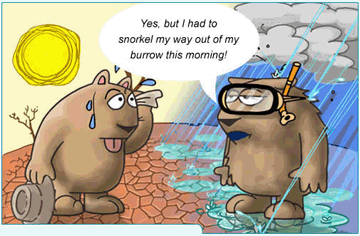Ecology of Climate Change

Courtesy The River
Research and Publications
Global climate change will be an inevitable factor in the lives of humans and wildlife, but our understanding of the ramifications of climate change on biodiversity is limited. How will animals respond to climate change? What components of climate change will be most detrimental to which animals? How will climate change interact with other factors to elevate or reduce risks? How will climate change affect disease? These are just some of the questions in which we are interested. We are particularly intrigued by the effects of enhanced or reduced climate variability on immune functions and subsequent disease risk in ectotherms, and on interactions between climate change and pollution.
Sample Publications
Taylor, R.A., Ryan, S.J., Lippi, C.A., Hall, D.G., Narouei-Khandan, H.A., Rohr, J.R., Johnson, L.R. in press. Bayesian quantification of the fundamental thermal niche of Huanglongbing, a vector-borne pathogen of citrus trees. Journal of Applied Ecology
Rohr, J.R., Civitello, D.J., Cohen, J.M., Roznik, E.A., Sinervo, B., Dell, A.I. in press. Different metrics of thermal acclimation yield similar effects of latitude, acclimation duration, body mass, and their interactions on acclimation strengths. Global Change Biology
Cohen, J.M., McMahon, T.A., Ramsay, C., Roznik, E.A., Sauer, E.L., Bessler, S., Civitello, D.J., Delius, B.K., Halstead, N.T., Knutie, S.A., Nguyen, K., Ortega, C.N., Sears, B., Venesky, M.D., Young, S., Rohr, J.R. 2019. Impacts of thermal mismatches on chytrid fungus Batrachochytrium dendrobatidis prevalence are moderated by life stage, body size, elevation and latitude. Ecology Letters 22: 817-825 Cover article
Cohen, J.M., Civitello, D.J., Venesky, M.D.†, McMahon, T.A., Rohr, J.R. 2019. An interaction between climate change and infectious disease drove widespread amphibian declines. Global Change Biology 25: 927–937
Sauer, E.L., Fuller, R.C., Richards-Zawacki, C.L., Sonn, J., Sperry, J.H., Rohr, J.R. 2018. Variation in individual temperature preferences, not behavioral fever, affects susceptibility to chytridiomycosis in amphibians. Proceedings of the Royal Society of London B 285: 20181111.
Rohr, J.R., Civitello, D.J., Cohen, J.M., Roznik, E.A., Sinervo, B., Dell, A.I. 2018. The complex drivers of thermal acclimation and breadth in ectotherms. Ecology Letters 21: 1425–1439 Cover article
Cohen, J.M., Lajeunesse, M.J., Rohr, J.R. 2018. A global synthesis of animal phenological responses to climate change. Nature Climate Change 8: 224-228
Mordecai, E.A., Cohen, J.M., Evans, M., Gudapati, P., Johnson, L.R., Miazgowicz, K., Murdock, C.C., Rohr, J.R., Ryan, S.J., Savage, V., Shocket, M., Stewart-Ibarra, A., Matthew, M.B., Weikel, D.P. 2017. Temperature characterizes Zika, dengue and chikungunya transmission potential in the Americas. PLoS Neglected Tropical Diseases 11(4): e0005568. https://doi.org/10.1371/journal.pntd.0005568
ISI Highly Cited
Cohen, J.M., Venesky, M.D., Sauer, E.L., Civitello, D.J., McMahon, T.A., Roznik, E.A., Rohr, J.R. 2017. The thermal mismatch hypothesis explains outbreaks of an emerging infectious disease. Ecology Letters 20: 184–193 Cover Article, Featured in Nature: Sohn Hothouse of disease 543: S44–S46
Raffel, T.R., Halstead, N.T., McMahon, T.A., Davis, A.K., Rohr, J.R. 2015. Temperature variability and moisture synergistically interact to exacerbate an epizootic disease. Proceedings of the Royal Society of London B 282:20142039
Landis, W.G., Rohr, J.R., Moe, S.J., Balbus, J.M., Clements, W., Fritz, A., Helm, R., Hickey, C., Hooper, M., Stahl, R. 2014. Global climate change and contaminants, a call to arms not yet heard? Integrated Environmental Assessment and Management 10:483-484
Rohr, J.R., Raffel, T.R., Blaustein, A.R., Johnson, P.T.J., Paull, S.H., Young, S. 2013. Using physiology to understand climate-driven changes in disease and their implications for conservation. Conservation Physiology 1:cot022-cot022
Rohr, J.R., Palmer, B.D. 2013. Climate change, multiple stressors, and the decline of ectotherms. Conservation Biology 27:741-751
Li, Y., Cohen, J.M., Rohr, J.R. 2013. A review and synthesis of the effects of climate change on amphibians. Integrative Zoology 8:145-161 Ranked as one of the four best papers published in the journal in 2013 https://mail.google.com/mail/u/0/?pli=1#inbox/1448714d25f3d5bf
Rohr, J.R., Johnson, P., Hickey, C.W., Helm, R., Fritz, A., Brasfield, S. 2013. Implications of global climate change for natural resource damage assessment, restoration, and rehabilitation. Environmental Toxicology and Chemistry 32: 93-101
Raffel, T.R., Romansic, J.M., Halstead, N.T., McMahon, T.A., Venesky, M.D., Rohr, J.R. 2013.Disease and thermal acclimation in a more variable and unpredictable climate. Nature Climate Change 3: 146-151 (featured in News and Views, article by Ross Alford: http://www.nature.com/nclimate/journal/v3/n2/full/nclimate1812.html; Altmetric score of 36, 97th percentile)
Rohr, J.R., Dobson, A.P., Johnson, P.T.J., Kilpatrick, A.M., Paull, S.H., Raffel, T.R., Ruiz-Moreno, D., Thomas, M.B. 2011. Frontiers in climate change-disease research. Trends in Ecology and Evolution. 26: 270-277
Rohr, J.R., Halstead, N.T., Raffel, T.R. 2011. Modeling the future distribution of the amphibian chytrid fungus: The influence of climate and human-associated factors. Journal of Applied Ecology. 48: 174-176
Rohr, J.R., Sesterhenn, T., Stieha, C. 2011. Will climate change reduce the effects of a pesticide on amphibians?: Partitioning effects on exposure and susceptibility to pollution. Global Change Biology. 17: 657-666
Raffel, T.R., Michel, P.J., Sites, E.W., Rohr, J.R. 2010. Does temperature drive chytrid infections in newt populations? Associations with leaf litter, vegetation and shade. Ecohealth. 7: 526-536
Raffel, T.R., Johnson, P.T.J., Paull, S.H., Rohr, J.R. 2010. Symposium 16, Towards a general theory for how climate change will affect infectious disease. Bulletin of the Ecological Society of America. 91: 467-473
Rohr, J.R., Raffel, T.R. 2010. Linking global climate and temperature variability to widespread amphibian declines putatively caused by disease. PNAS. 107: 8269-8274
Rohr, J.R., Raffel, T.R., Romansic, J., McCallum, H., Hudson, P.J. 2008. Evaluating the links between climate, disease spread, and amphibian declines. PNAS. 45: 17436-17441
Raffel, T.R., Rohr, J.R., Kiesecker, J.M., Hudson, P.J. 2006. Effects of temperature and temperature changes on amphibian immunity under field conditions. Functional Ecology. 20: 819-828
Rohr, J.R., Palmer, B.D. 2005. Aquatic herbicide exposure increases salamander desiccation risk eight months later in a terrestrial environment. Environmental Toxicology and Chemistry. 24:1253-1258
Rohr, J.R., Elskus, A.A., Shepherd, B.S., Crowley, P.H., McCarthy, T.M., Niedzwiecki, J.H., Sager, T., Sih, A., Palmer, B.D. 2004. Multiple stressors and salamanders: Effects of an herbicide, food limitation, and hydroperiod. Ecological Applications. 14:1028-1040
Rohr, J.R., Madison, D.M. 2003. Dryness increases predation risk in efts: Support for an amphibian decline hypothesis. Oecologia, 135: 657-664
For a full list of publications, please see the Publications page on this website.


